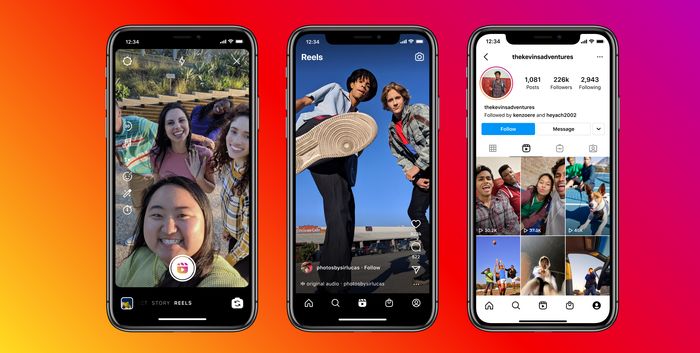The challenge is that in the increasingly important fight for video dominance, Meta faces a heavyweight rival that is only getting stronger.
While Meta executives said Reels is now the company’s fastest-growing content format, ByteDance Ltd.’s TikTok is growing even faster. It was the most-downloaded app of 2021, and overtook Meta’s Instagram in popularity among coveted young users.
That makes a switch to Reels and away from TikTok a tough sell for a lot of advertisers and creators.

Meta’s Instagram Reels allows users to watch, create and share short videos.
Photo: Meta
“The thing that is somewhat unique here is that TikTok is so big as a competitor already and also continues to grow at quite a fast rate off of a very large base,” Meta Chief Executive Mark Zuckerberg told analysts Wednesday afternoon. “Even though we are compounding extremely quickly, we also have a competitor that is compounding at a pretty quick rate too.”
Meta launched Reels on Instagram in the U.S. in August 2020 as its answer to TikTok. The company launched a Facebook version of Reels in September. The company has yet to break out Reels’s exact usage figures, but outside research shows it is falling farther behind TikTok in the battle for younger users.
In 2021, TikTok reached 63% of Americans between the ages of 12 and 17 weekly, up from 50% a year prior, according to a November survey by Forrester. Instagram, meanwhile, declined from 61% in 2020 to 57% in 2021. Other industry data shows similar trends.

Two livestreamers selling handbags on TikTok.
Photo: VCG/Getty Images
“The overall negative perception of Facebook and Instagram is impeding their ability to bring in new, younger users,” said Brendan Gahan, partner at Mekanism, an independent ad agency. “Instagram is not the ‘cool’ app anymore. It’s lost its luster, is aging up and losing traction.”
A Meta spokesperson declined to comment beyond what executives said on Wednesday’s earnings call.
Although Meta provides massive audiences of multibillion monthly users on Facebook and Instagram, advertisers say TikTok offers a way to reach younger users, start trends and affect culture in ways other platforms can’t.
“We have a lot of engagement [on TikTok], we have a lot of buzz. It sparks a lot of virality that halos outside of TikTok,” said Bennie Reed, senior vice president of connections strategy at Deutsch LA, a creative advertising studio.
The distinction in reach can be felt among creators who post on both apps.
Andre Brown, who goes by @mrpresidentstiktok on TikTok, said he posts daily on both TikTok and Instagram. His videos on Instagram Reels average 15,000 views. Those he posts on TikTok average more than 100,000 views and can often go well into the millions.

Andre Brown says he posts daily on both TikTok and Instagram.
Photo: Andre Brown
Although Mr. Brown gets paid for his Reels out of a $1 billion creator fund Meta announced last year, he estimates that 85% of his total revenue comes from brand deals he strikes for his videos on TikTok.
“If you want to get reach, if you want to get your content out there, TikTok is still hands down-the number one way for exponential growth,” he said.
Meta’s fund has helped to draw in those who make content for Reels, though it illustrates that attracting creators can be expensive. Among them is 20-year-old Austin Becker of Minnesota. Mr. Becker began posting Facebook Reels in December, and he has already made $2,500 from his work.
“You don’t have to go mega viral to get paid either,” said Mr. Becker, who is known as @AustinBspooky on Facebook. “If you have consistent views, even if they’re in a lower range like between 10,000 and 20,000, you could still make a decent amount of money every month.”
Mr. Becker switched to Reels after making videos for Snap Inc. He says he had made $40,000 from Snap’s creator fund, but after the company lowered the payments, Mr. Becker’s revenue stream dried up and he stopped posting.

Austin Becker switched to Reels after making videos for Snap.
Photo: Austin Becker
For now, Mr. Becker said he is happy to make content for Meta so long as those payments keep coming.
“This is a really fun career path if you can make it work,” he said. “And if it doesn’t work in one place it’s worth a try somewhere else. So if the fund dries out, I’ll go elsewhere.”
Reels is already the biggest contributor to engagement growth on Instagram and is growing very quickly on Facebook too, Mr. Zuckerberg told analysts. However, Reels has also begun cannibalizing usage of Instagram and Facebook’s Feed and Stories features—the company’s biggest moneymakers.
Mr. Zuckerberg said he is confident that advertising will ramp up on Reels and that the company will be able to transition its revenue streams just as it did when it pivoted from desktop to mobile and then from Feed to Stories. But, Mr. Zuckerberg cautioned, “there’s a lot of work to do here.”
Meta has done it before. It most notably duplicated Snap’s ephemeral feature—in which montages of photos or videos disappear after 24 hours—in launching its Stories format, which proved popular with users. In that instance, however, Meta was going against a much-smaller rival that wasn’t yet entrenched across the culture.
“Rolling over Snap was kind of like pushing your little sister down when she’s 1 and you’re 4,” said Insider Intelligence Principal Analyst Debra Aho Williamson. “TikTok is like your brother after he’s gone through his high-school growth spurt—you can’t push him down that easily.”
Write to Salvador Rodriguez at [email protected]
Copyright ©2022 Dow Jones & Company, Inc. All Rights Reserved. 87990cbe856818d5eddac44c7b1cdeb8








